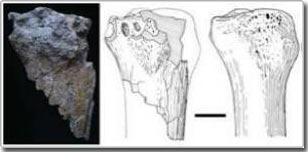Giant rhino fossils in Anatolia
French scientists reported that Anatolia was not an isolated land 25 million years ago (during the Oligocene period), contrary to previous thoughts. Anatolia is a peninsula located in the westernmost part of Asia, currently in the Asian territory of Turkey (96% of Turkey's mainland area, the remaining 4% belongs to Thrace).
This conclusion is due to the first fossil bone analysis of rhinocerotoid rhino discovered in 2002 in the Anatolia field during a French-Turkish paleontological survey. The presence of this bone in Anatolia, along with the associated fauna remains, is a sign of animal migration between Europe and Asia. The results of the study, published in the March 2008 online edition of the Zoological Journal of the Linnean Societ, question the Anatolia's separation, which is still considered an archipelago.
This is the first time a fossil bone fragment of a giant rhinocerotoid species dating from the Oligocene period (the period corresponding to strong stratigraphic activity around the Mediterranean Sea) was discovered in Anatolia. Discovered in 2002 during a trip to study paleontology in the ÇankiriÇorum region (central

The rotating bone of baluchithere Paraceratherium, discovered in 2002, dates from the Oligocene period in central Anatolia (Turkey 25 million years ago).Left photo : front of the sample. Middle photo: picture of the same specimen. Right photo : compared to the largest known specimen of baluchithere (also during the Oligocene period in Mongolia)
Anatolia, Turkey), the bone fragment described by scientists is 1.2m long and probably belongs to a very large male (up to the shoulder about 5m high, belonging to the Paraceratherium genus group).
This herbivore, known as baluchitheres or indricotheres, is considered to be the largest mammal that ever existed, the size of the largest mammoth (about 5m in height to the shoulders, heavy body 15 to 20 tons.
Along with the model Paraceratherium, this species exists in Pakistan, China, Mongolia and Kazakhstan; traces of rodents are also in the mine. They allow to determine the life of the sample at about 25 million years and show close relationships with animal populations in Asia and / or Europe. This observation is particularly surprising in that Anatolia is still considered an archipelago at the time, separate from both Europe and Asia with a sea of names called Paratethys, Black Sea, Caspian and Aral today only part of the water block above.
This discovery thus proves the existence of ground relations and the close proximity of Europe (including France) to Asia (China, Mongolia, Pakistan) at this stage. Therefore, during the Oligocene period, Anatolia was not isolated by the sea and at least one isthmus: animals could thus cross the mainland from mainland Asia to Anatolia.
On the other hand, the discovery also confirmed that there was indeed a separation from Africa, because today there are no species in Africa during the Oligocene period in Anatolia.
- Mother of the giant rhino launched in America
- Discovered an ancient rhino that has never been seen in Thailand
- Russia discovered thousands of years of rhino fossils
- Rhino protection campaign
- Giant fossils and the fear of prehistoric creatures
- Save the rhino's synthetic rhino horn
- In just a few years, the rhino will become extinct
- South Africa combats rhino poaching with chips and DNA
- Inject poison into rhino horn to prevent poaching
- The piece of rhino horn and the man spirit
- Rhino is a rare white color born
- Discover dinosaur fossils like real Loch Ness monsters
 Discovered an ancient centipede fossil 99 million years old
Discovered an ancient centipede fossil 99 million years old Discovered bat-like dinosaurs in China
Discovered bat-like dinosaurs in China Discovered a 200-year-old bronze cannon of the coast
Discovered a 200-year-old bronze cannon of the coast Discover 305 million-year-old spider fossils
Discover 305 million-year-old spider fossils